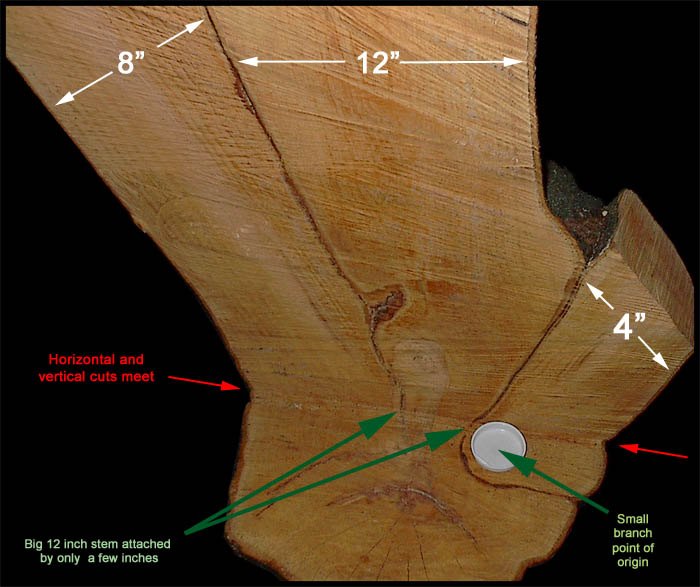
Included Bark and Corrective Pruning
Copyright 2011 by M. D. Vaden
The image below shows part of the trunk from a flowering plum. It's a display I made for a garden show and pruning class. The trunk has a cross-cut horizontally that the white cap is resting on, and a vertical cut down the middle to reduce weight and show the inside.
This piece shows the problems that develop when pruning is neglected and postponed. These problems are basically irreversible. There are multiple weaknesses. .

The thin dark areas between the stems are included bark. Odds are that when this flowering plum was planted, those stems or limbs were not even touching. As each limb grew wood and diameter each year, the sides eventually met, pinching or trapping the bark in-between. The problem being that the bark did not fuse or bond when it touched-together. It merely became embedded: often is just dies. Once the bark is stuck between like this, the cambium can't expand and build up more wood for strength.
This was likely a poorly formed plant anyway. But the structure could have been improved by limb removals on the left and the right sides, over a few years. The center stem should have been the widest in the beginning. But it became restricted and is attached with less wood in the middle than the limb on the left side now. The center stem was about 12 inches diameter up higher, but it is connected in the middle by only a few inches of wood between the dark included bark shown by the green arrows.

advertisement
The limb that is roughly 4 inches diameter, originated right next to the trunk where the white cap is. The 4 inch limb was probably 1/2 to 1 inch during planting. that structural problem could have been eliminated in less than one minute with a hand pruner.
The left limb could have been removed a couple of years later in less than a minute with a handsaw.
Because the structure was not corrected with selective pruning cuts, this flowering plum basically disintegrated. You can't see it in this image, but similar problems were allowed to remain in the upper canopy and it split apart from snow or rain weight around 2002.
After included bark becomes wedged like this, limbs can split apart: sometimes as easy as peeling a banana or splitting a wishbone. It is weak and the bark is not attached. Only a few species seem to improve with some natural grafting or bonding, called inosculation. But most of the time, the tissue by the bark does not fuse or bond.
This shows why corrective pruning or structural pruning is essential at yearly or bi-yearly intervals, beginning a short time after planting.
Eventually, this developed into a chainsaw project. In the beginning it would have just been a project for loppers, a handsaw or hand pruners. A few years after pruning, the small limb on the right may have needed a combination of handsaw and a chisel. Each year this is allowed to go on, the choice of pruning tools that is needed can change.
The same thing applies to big shrubs too, just on a smaller scale.